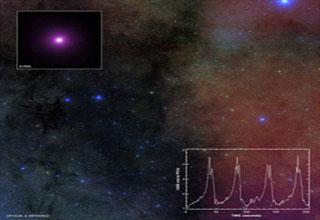
The main graphic shows the crowded field containing GRS 1915 in optical light. Photo: NASA
WASHINGTON (BNS): Researchers have discovered the "heartbeats" seen in the light from an unusual black hole system by using two NASA X-ray satellites, a media report said.
These results give new insight into the ways that black holes can regulate their intake and severely curtail their growth.
"Trying to understand the physics of this 'heartbeat state' is a little like trying to understand how a person's heart beats by watching changes in the blood flow through their veins," Science daily quoted Joey Neilsen, a graduate student at Harvard University, who presented these results from his dissertation at the American Astronomical Society (AAS) meeting in Seattle, Washington as saying.
The astronomers studied and examined the GRS 1915+105 (GRS 1915 for short), a binary system in the Milky Way galaxy containing a black hole about 14 times more massive than the Sun that is feeding off material from a companion star.
As this material falls towards the black hole, it forms a swirling disk that emits X-rays. The black hole in GRS 1915 has been estimated to rotate at the maximum possible rate, allowing material in the inner disk to orbit very close to the black hole, at a radius only 20% larger than the event horizon, where the material travels at 50% the speed of light.
According to the Science Daily, using the Chandra X-ray Observatory and the Rossi X-ray Timing Explorer (RXTE), researchers have monitored this black hole system over a period of eight hours. As they watched, GRS 1915 gave off a short, bright pulse of X-ray light approximately every 50 seconds, varying in brightness by a factor of about three. This type of rhythmic cycle closely resembles an electrocardiogram of a human heart -- though at a slower pace.
Changes in the X-ray spectrum observed by RXTE during each heartbeat reveal that the inner region of the disk, at only a few times the radius of the black hole's event horizon, emits enough radiation to push material away from the black hole. Eventually the disk gets so bright and so hot that it essentially disintegrates and plunges towards the black hole and then the cycle begins again.
The astronomers also used Chandra's high-resolution spectrograph to study the effects of this heartbeat variation on regions of the disk very far from the black hole, at distances of about 100,000 to a million times the radius of the event horizon. By analyzing the Chandra spectrum, they found a very strong wind being driven away from the outer parts of the disk. The wind changed significantly in just 5 seconds, nearly 100 times faster than has ever been seen in a wind from a stellar-mass black hole.
The researchers concluded that the strong X-ray pulse from the inner disk must heat the outer disk. This heating process launches a wind, so that each new pulse drives more wind from the disk. The rate of mass expelled in this wind is remarkably high, as much as 25 times the maximum rate at which matter falls onto the black hole, it said.
This massive wind drains material from the outer disk and after a couple weeks, this depletion affects the inner disk, causing the black hole to feed much more slowly and its X-ray brightness to decrease substantially. Unable to power such strong variations in the disk and the wind, GRS 1915's 'heart' ceases to beat. This remarkable system then likely begins one of its 13 other known patterns of variation.
 Previous Article
Previous Article Next Article
Next Article













The Indian Air Force, in its flight trials evaluation report submitted before the Defence Ministry l..
view articleAn insight into the Medium Multi-Role Combat Aircraft competition...
view articleSky enthusiasts can now spot the International Space Station (ISS) commanded by Indian-American astr..
view article